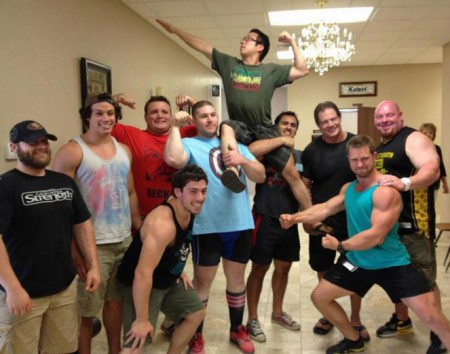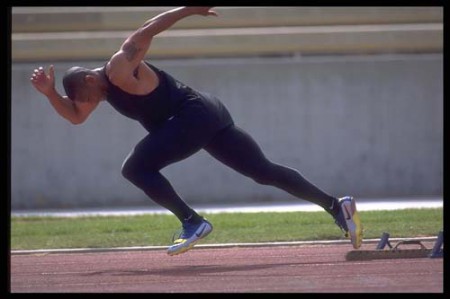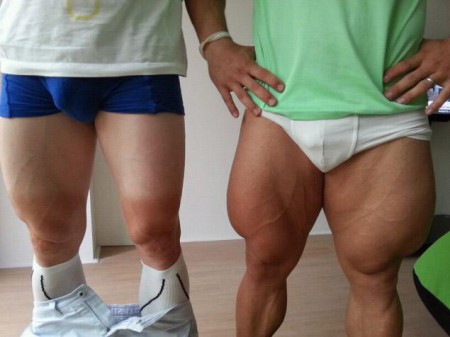I’ve been trying to figure out how I’m going to write about this meet for a while, and I think I’ll talk about some general stuff, quickly recap the lifters, and then tomorrow expand on the lessons learned (mostly the hard way). I handled 11 lifters over this three day meet, but had some help here and there. I’d like to thank the following people for helping:
Mike Battaglino, one of my closest friends, has a good coaching and programming eye; he’s going to be a very good powerlifting coach. He helped choose some attempts and managed some warm-ups in the instances where I had multiple lifters in the same session. Elliot Rowe handled all of the filming duties on Saturday, and for that we are grateful Jacob Tsypkin, Elliot’s coach, would drop whatever he was doing and help load warm-up bars for the lifters. Chris partially took the handling duties of one of the younger lifters from Wichita Falls while I handled AC and Norman on another platform. Brent, AC, Norman, AJ, and Big Cat also helped at various points that made it possible for me to focus on preparing the athlete and counting attempts. Thanks everyone.

L to R back row: Jacob Tsypkin, Norman, Chris, Mike, Brent, AC, Sean Culnan, E.C. Stumpf.
Front row: Elliot Rowe and Justin
Of the 11 lifters, I’d say that 6 of them had pretty good meets. I personally played a role in the preparation of AC, Chris, and Mike (Brent does his thing, but he gave me more control of his attempts). Courtney, Wendy, Sean, Jordan, Andrew, Drew, and Norman had prepared on their own. I helped Jordan taper, have coached Courtney before, and have been friends with Norman for a while yet never coached him. Handling lifters is all about getting the most out of what they can do on that day, and I think I did that for pretty much everyone, especially Courtney, Wendy, Sean, Jordan, AC, and Chris (the others typically had circumstances they couldn’t control). In chronological order:
Friday
Courtney Modecki is a strong little girl who has been involved with CrossFit for a while and lifted in the 132 class. She trains at Outlaw CrossFit, was on their affiliate team, and rotates through strength training, CrossFit regionals, weightlifting, and now powerlifting throughout the year. She has a lot of potential in both powerlifting and weightlifting. Since Jennifer Thompson dropped back down to the 132 class, our goal was to get second place and hit meet PRs. Note that gym PRs are not the same as meet PRs; they’re largely irrelevant for competitors. I planned all of her attempts based on her high-end goals and what she hit recently in training.
Courtney opened the squat with a no-big-deal 253. She was then red lighted for depth on her second squat of 275. The squat wasn’t hard, and I was confident I could cue her to fix it, so I made a 5kg jump to 287 lbs. We originally wanted closer to 297 on the high end, but missing 275 changed things. I gave her the cues, sent her out, and she made good on the 3rd attempt of 287, setting a meet PR (she may have had enough for 292, but I’m happy with the 287 call). Courtney then went 3 for 3 on bench, hitting 127, 138, and 148 in succession. I don’t remember any issues on bench; as she focuses on this sport, her bench will improve. We opened lighter on the deadlift at 292 and then hit a medium to moderately difficult 325 on the second. It wasn’t hard enough where I didn’t think I couldn’t make a 12.5kg jump to 353, but Courtney was out of gas on the third attempt and missed it. I attribute this to her training — a Sheiko volume program doesn’t allow any higher intensity lifts, so she wasn’t adapted to hitting several maximal lifts on squat and deadlift. Not to mention she traveled, was at her first national meet, and was tired. In any case, finishing with 287/148/325 gave her second place at her first raw nationals. Courtney has the most room to improve on the deadlift (she’s pulled 365 in the gym), but her squat and bench will steadily improve with consistent attention.
Brent Kim is Brent Kim. For the most part he has a template he sticks to, but it’s broken up by his work schedule and biceps curls (I think). I guess his training was regular leading into this meet, but he had commented that he hadn’t deadlifted a whole lot. A difference between last year and this year is that Brent high bar squats. He had decided on some openers, but I talked him into changing some of them (he beheld the instrument of his liberation). We took 418 on his opener, then a 7.5kg jump to 435. We then made another 7.5kg jump to 451 and he missed it. My guess is his training hasn’t been conducive to multiple high intensity squat sets. This can be easily rectified, even if Brent keeps splitting time between weightlifting, powerlifting, and swollertrophy. He’s looking good, by the way (the fire rises).
Brent went 3/3 on bench, which I think might be a PR, but he meet PR’d with 275 on the third. I think it was satisfying to him to hit that milestone, because he was abnormally happy after the lift. Brent wanted to open kind of heavy on his deadlift, and I talked him into opening lower so that we could get his third. He hit 386 as a “last warm-up on the platform”, then 430. It didn’t look fast, but I still called for 463 on the third. He missed it after getting it off the floor (he didn’t feel in charge). At the time I felt that it may have been something he could have ground through (he seemed to just turn off when it it slowed), yet it’s a function of apparently not deadlifting a lot, and therefore not being used to the tension at that intensity. Squatting and deadlifting around 430 at 154 pounds is still good, but I felt that I could have gotten a bit more out of Brent and it’s bothered me since. Maybe it’s because Rachel wrote a leh-uh, and in that leh-uh, she chose Hah-veeh. Even though he didn’t hit the numbers we wanted, Brent still got 5th place.
Wendy Hajik is my new buddy who trains at the same gym as Brent (he avoids speaking with her along with any other female). Brent sort of introduced us and I asked who she was there with, and she was about to compete in her second national meet by herself. II offered to at least count attempts for her if she wanted it. She accepted, so I helped her warm-up and got her ready for squat. Wendy has short, explosive upright squats with a high bar; short femurs are good for that. She was set on her openers but said she would “figure it out based on how it felt”. That’s not really how I roll when I handle someone, but I didn’t want to interfere or change much since we had just met.
Wendy opened with 304 pounds on the squat. She crushed the opener and…then stepped forward before the rack command and was red lighted. I felt terrible because I always tell my lifters to wait, especially on the first squat. I had the impression she was more experienced than her four previous meets (I found this out later); it was also her first national meet. I still feel like it was my responsibility, I just didn’t want to over step my bounds as a handler when I had just met her. In any case, she took the same weight on the second attempt and…shifted her hips backwards and missed the second attempt. I would later find out that her weightlifting shoes were stolen a couple weeks prior; the minimalist running shoes she’s wearing undoubtedly attributed to the technique miss.
At this point Wendy is borderline freaking out at bombing out of the meet. People keep coming up to her and talking to her. They all walked away and I said, “Look, I don’t know what all of these people are saying, but you’ve done thousands of squats before, right? This next one won’t be any different. Take a deep breath. Visualize what a normal squat feels like. You’ll be fine.” I had her relax and visualize a few times as she waited. When her bar was loaded, she walked out, went through her routine and…squatted the weight up for three white lights. When they beamed, she IMMEDIATELY burst into tears, sprinted, and jumped into my arms. And stayed there for ten seconds. I actually walked back to the warm-up room carrying her. I didn’t realize how nervous she was, because, in her words, she “gets pretty zen” before doing a lift. It was a high pressure situation and she came through for an impressive 304 squat — a bit more than double body weight (148 lb weight class).
Wendy went 2/3 on bench, hitting 134, then sort of a hard 148 (a 7.5kg jump). I made the smallest jump (2.5kg) to her third at 70 and she missed it. No big deal; who benches anyway? Wendy opened on deadlift with a simple 314 lbs. Then we took 331 for a moderate second attempt. At this point, things were getting fun. She was competing with another lifter, Jill Joiner-Wong for second place (1st place was locked up by world champion Kimberly Walford, who had a completed deadlift of 507 red lighted in this meet!). Jill called for 342 on her final deadlift and so we called for 353 to have a 2.5kg edge in the total (Wendy squatted more than Jill, Jill benched more than Wendy, and success with Wendy’s 353 would mean she totals 2.5kg more [Jill was lighter, so tying the total would have let Jill win 2nd]).
I asked Wendy four times if she wanted baby powder on her thighs. She insisted in wouldn’t be an issue. This would prove to be a regrettable decision. Wendy pulled a very hard third attempt with 353 and slowly locked it out…yet her leg movement and the bar sticking to her thighs resulted in the judges red lighting it for hitching. Had I applied baby powder to her legs, she would have gotten it.
Not a bad meet, especially with how the squat started. I know how I’ll handle these situations in the future by always cuing the “wait” before the first squat and applying the baby powder, but I’m pretty sure Wendy will use it forever from now on. Wendy also qualified for the Arnold, so we’ll see her again there.
Sean Dunston trains at Outlaw CrossFit and has posted on 70’s Big since the beginning. He competed in the master’s and open 181 class (I handled 2 other lifters in this class). He squatted 435 and 457, so we went for a national master’s record of 480 on the third attempt. Unfortunately it just wasn’t there that day, but I think it’s doable in the future. Sean then went 3/3 on bench hitting 220, 237, and 254. He opened deadlift with an easy 440, hit a second attempt of 474, and then hit a meet and lifetime PR deadlift of 507. There was more in the tank as well, but he was happy with that pull and it capped off a great meet. Sean finished 8/9 and I think he got second in his master’s class.
Jordan Feigenbaum is a meticulous lifter who was competing in his second meet (first nationals) and aimed to qualify for the Arnold. His body fat sits at sub 7%, so he’ll eventually move into the 198 weight class (he has room to fill out, he’s around 5’10” or so). We opened with 419 and then hit 441 on the second attempt. He missed his third of 463, and I sort of recall it being a mechanical issue. Had he been thinking “push hips”, he would have kept his posterior chain engaged instead of shifting forward into the quads. Jordan opened on bench at 308, then hit 320, but had a crack at 331 before missing it. He opened with a solid 507 opener, qualified for the Arnold with a 529 second attempt, and that had a really solid battle on a successful third attempt at 551. I was really happy to see Jordan hit the 551, especially since we didn’t get his third squat and bench. I think modifying his training can facilitate the third attempts on the other lifts. Great second meet for Jordan, he qualified for the Arnolds, and he finished 8th overall in a very competitive 181 class.
Andrew Pichardo is a friend of Chris’ from Wichita Fallsand was also competing in the 181 session in his second meet (first national meet). I wasn’t present at the fellas’ weigh-in because I went to get breakfast (one of my two main meals of the day), so I missed the fact that Andrew’s squat opener was incorrectly labeled as 220kg AKA 485 — higher than what we planned for his third attempt. The actual attempt was supposed to be 200kg AKA 441, and I just didn’t pay attention to what was on the chart projected on the wall. As the coach, I should have double checked all of the openers (there were two instances of openers being wrong later in the weekend, one was the lifter’s fault, the other the judge’s fault) and I feel that this is my fault. I didn’t find out about the wrong weight until Andrew was pinned on his first attempt. When the bar was loaded it was too late anyway, because he signed the card. Still, I could have prevented the snafu. I took him in the back to hit 445, and it was a grinder; he barely got it. I had to tell him that he wouldn’t be getting any squats that day and I waved his third attempt.
We had trouble on his first two bench attempts at 270 (I can’t recall exactly what the problem was), but he came back and made good on a third attempt at the same weight. At this point I feel terrible and only want Andrew to deadlift well since the world has gone to shit on squat and bench. We hit 463 on the first, then a moderate 507 on the second attempt. It wasn’t slow enough that I didn’t have issues calling for 546 on the third (lower than what he originally planned if I recall), but when you aren’t adapted to multiple high intensity pulls and you cut weight for the meet, it results in being fatigued for third attempts at a national meet. The 546 didn’t go. Andrew and I both learned a lot at this meet, and I felt terrible for him because I knew I could have prevented it from happening. This experience leaves a bad taste in my mouth because I messed up, but he got to experience his first national meet and still hit 507 in competition.
The next update will have the rest of the lifters.





